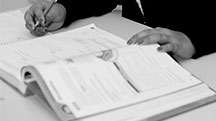
By Toya Stewart Downey, April 8, 2015
Each winter the Minnesota Department of Education releases a statewide look at graduation rates for high school students. This year’s results showed a three-year increase of eight percentage points for Native American students across the state, but it’s still not enough, according to many educators and tribal leaders.
The graduation rate for Native American students moved from 42.41 percent in 2011 to 50.6 percent in 2014, but those numbers are far lower than for other student groups, according to the state’s education department.
The rate for Minnesota’s Native American students is the second worst in the nation. The on-time graduation rate for Native American students is one of the lowest in the nation.
“It seems like there’s a trend we’re seeing: if students can make it through the ninth grade they are making it through high school,” said Suzanne Wise, Mille Lacs Band Commissioner of Education. “But, if they struggle before then, there’s a chance they won’t make it to graduation.
It’s a problem the Band is working to solve, Suzanne said.
“We have learned that one-on-one support matters even when students get to high school,” she said. “We know that adolescence plays a role, and we know that sometimes Indian students are treated differently from non-Indian students. All those things can impact a student’s ability to succeed in school.”
A particular problem in the Mille Lacs Band is that truancy is high, which also means students might have a harder time reaching graduation, Suzanne said.
“At Nay ah Shing we haven’t made Adequate Yearly Progress because of attendance,” Suzanne said. “Getting kids to school is a huge undertaking.”
Adequate Yearly Progress, commonly called AYP, is a measurement defined by the federal No Child Left Behind Act that allows the Department of Education to determine how every public school and school district in the country is performing academically based on results from standardized tests.
To address the issue representatives from family services, law enforcement, tribal courts and other agencies have been meeting to find a way to get students to schools. There’s a move to bring truancy to the tribal court system, and police officers have been seeking out truants to encourage them to attend school. Nay Ah Shing has hired an American Indian Parent Involvement Coordinator to help its efforts.
“We’ve built up strong parent involvement at the school and it’s been successful,” she said. “We have more parents at teacher conferences. We are seeing more involvement at the school and more student growth.”
Still, she said, attendance is a struggle and will take more intervention efforts to help change the mentality about the importance of attending school and then graduating.
‘If kids don’t feel like they are getting anything from coming to school, then they won’t come. We are looking at adding more things to our schools to make them more inviting and to make the kids feel more vested in school.”
Suzanne is hopeful that the Band’s Niigaan program, which was formerly the Boys and Girls Club and has shown some success in engaging students in school, will continue to grow.
“Through the program we have added more people to work as school liaisons. We have found that it helps students,” she said. “We have made it a priority to reward students who are doing well in school in attendance, whose achievement has increased, and who are on the honor roll.”
The Niigaan model school is Isle. There the program has its own classroom, and its staff help with lunch periods and homework and tutor the students. The goal is to get more Niigaan staff into schools, Suzanne said.
“I want our children to know what success feels like,” she said. “I want them to graduate. To make that happen we need the support of their parents, their caregivers and the community.”
“By working together we can make a difference in their lives,” she added. “Native people are relational. To suggest it’s just up to the schools is not relational. It’s not the way Ojibwe people are supposed to be.”
In February, Native American leaders implored legislators to increase support for Native American education. The request came after a focus group comprised of tribal representatives met with state Education Commissioner Brenda Casselius to discuss the state of education for Native American students.
They asked for increased funding for mentoring efforts, and early childhood programs in school districts that serve Native American students. They also requested a boost in funding to supplement federal funds for tribally-operated schools, including the Band’s Nay Ah Shing school.
The tribal schools receive $5,000 a year per pupil from the federal government, but that is half of what other Minnesota districts receive from the state. Tribal leaders say that equalizing per-pupil funding could help improve achievement of Native American students and would help provide an equitable education for all students.